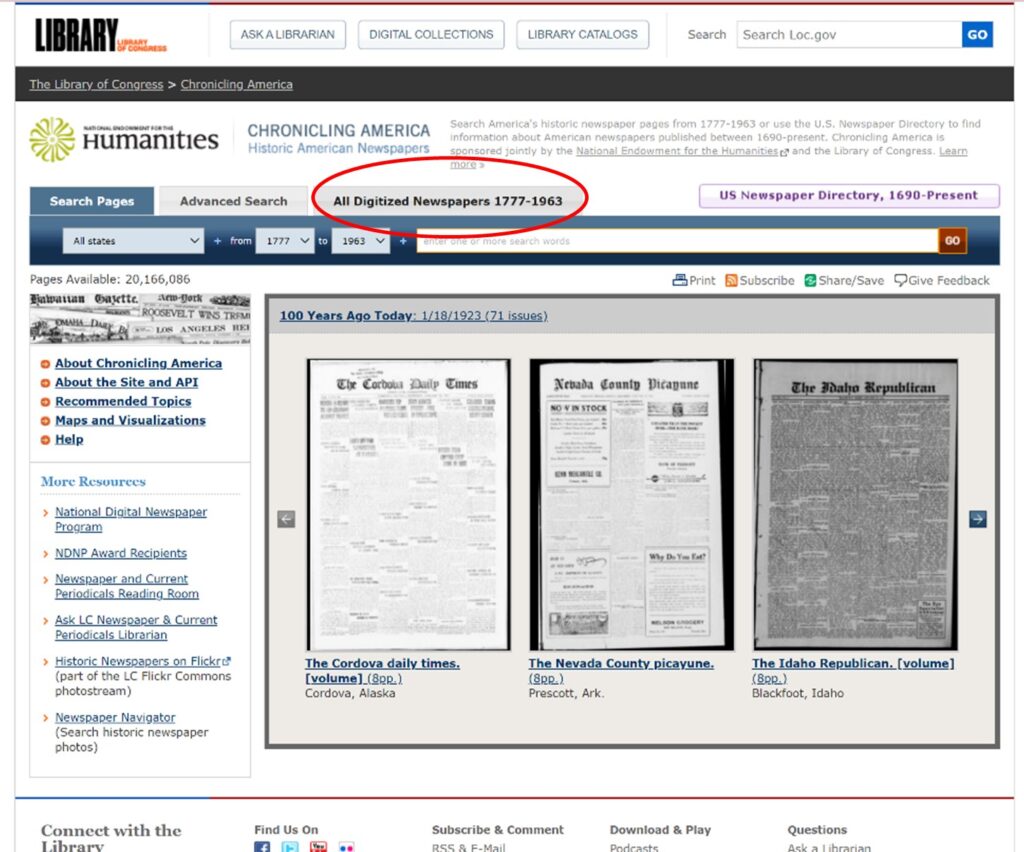calsfoundation@cals.org
Digitizing History: Arkansas State Archives and the National Digital Newspaper Program
In early May, the Arkansas Digital Newspaper Project (ADNP) team presented “Exploring the Arkansas Digital Newspaper Project” as part of the monthly Legacies & Lunch program at the Central Arkansas Library System (CALS). We wanted to follow that up with an overview of our involvement in the National Digital Newspaper Program (NDNP), discuss how to use the Chronicling America database for research, and respond to questions about post-1963 content missing from the database.
About the NDNP Project
The NDNP project is a partnership between the National Endowment for the Humanities (NEH) and the Library of Congress (LOC) to provide free online access to historic newspapers from across the United States and U.S. territories. Grants are awarded to one “cultural heritage institution” from each state or territory. Historic newspapers (1770-1963) from each state or territory are selected and digitized through a highly technical and standardized process to ensure that quality is uniform and LOC standards are met.
The goal is 100,000 pages by the end of a two-year grant cycle. Content is broken up into batches of 10,000 pages, and a single batch can take four to six months to complete, from the beginning stages to the final stage where content is “ingested” into the Chronicling America website database. Each state or territory typically completes three cycles, with the option to continue on a more competitive basis for further cycles. For more information about the NDNP project and participating states, visit https://www.loc.gov/ndnp/about.html.
Arkansas’s Contribution to the Project
 The Arkansas State Archives represents the cultural heritage institution from Arkansas, and it began work on the NDNP project in 2017 after it was awarded its first two-year (2017-2019) grant. An advisory committee of experts from across the state advised staff and recommended titles varied by the time period they covered, their geographic spread throughout the state, and their political or specialized focus. For each cycle, new and returning advisory board members guide ADNP staff in the selection of newspaper titles in order to get the most diverse coverage that conveys the history of Arkansas.
The Arkansas State Archives represents the cultural heritage institution from Arkansas, and it began work on the NDNP project in 2017 after it was awarded its first two-year (2017-2019) grant. An advisory committee of experts from across the state advised staff and recommended titles varied by the time period they covered, their geographic spread throughout the state, and their political or specialized focus. For each cycle, new and returning advisory board members guide ADNP staff in the selection of newspaper titles in order to get the most diverse coverage that conveys the history of Arkansas.
In our current third cycle of the project, our focus has been on underrepresented communities in Arkansas, including female-owned and -operated newspapers such as the Woman’s Chronicle and the Arkansas Ladies’ Journal (Pulaski County), minority-owned papers such as the Arkansas Mansion and the Arkansas State Press (Pulaski County), and foreign-language papers such as Arkansas Echo (Pulaski County) and Stuttgart Germania (Arkansas County).
Digitized Newspapers
To view a full list of Arkansas titles available on Chronicling America, visit https://chroniclingamerica.loc.gov/ and search “All Digitized Newspapers 1770-1963″ for Arkansas. New content is added to Chronicling America monthly. Each title includes an accompanying history of the paper detailing the significance of the paper, owners/publishers, the particular political or social slant, and interesting topics covered during its time in print.

How to Use the NDNP Project for Research
With a robust search function, along with high-resolution photographs, OCR (or Optical Character Recognition) technology, and cropping abilities, it is easy to sort and search for specific information from Arkansas newspapers (or any other participating state’s newspapers).
For example, to search for Juneteenth celebrations in Arkansas newspapers, select Arkansas from the drop-down menu and in the keyword box, use search terms such as:
- Emancipation Day
- Jubilee Day
- Freedom Day
- Liberation Day
(NOTE: When searching for a subject, you may need to look for alternative names. “Juneteenth” is the official name for the federal holiday, but it has been known by many names since its inception in the 1860s.)
By clicking on the title of each newspaper, you will be taken to specific information about that title, including location of the paper, publishing details such as how often the paper was published, different names the paper was published under, and an essay giving a history of the paper and its publishers, as well as the relevance to the history of Arkansas newspapers.
Another search feature offered on Chronicling America is the “US Newspaper Directory, 1690-Present.” This directory includes all U.S. papers that have been registered with the Library of Congress. This can be a helpful tool if you are looking for information about specific newspapers from across the state, as it lists which institutions have the microfilm. NOTE: All newspapers digitized on Chronicling America can be found in the U.S. Newspaper Directory, but not all those listed in the directory will be found on Chronicling America.
Copyright and Public Domain
We sometimes get questions about Chronicling America ending abruptly after 1963, complicating matters for those who are doing more contemporary newspaper research. This comes down to one thing: copyright. Copyright laws are complicated and have changed over the years. Here is a very brief history of copyright and how it affects the newspapers on Chronicling America.
- Historic newspaper content that was published more than ninety-five years ago is now in the public domain. This means that anything up to January 1, 1928, is available without copyright restriction. This changes each year, so next year, it will be content prior to January 1, 1929, and so on.

- Works created from 1928 to 1963 had to be registered to maintain copyright status. This was indicated by “©“ or using “Copyright” to indicate its status. At that time, in order to maintain copyright status, the work must have been renewed after twenty-eight years to keep the copyright protections. Many publications between 1928 and 1963 were never officially registered or renewed, so many newspapers, images, and comic strips are now part of the public domain as well. In order to assess copyright status, our team conducts extensive research in order to conclude that the newspaper, or those items contained within it, are part of the public domain before including it as part of the NDNP project.
- Works copyrighted after 1963, beginning January 1, 1964, up to December 31, 1977, fall under the Copyright Renewal Act of 1992, which automatically extends the copyright term and makes renewal optional. Therefore, any content beyond 1963 is still protected under copyright and, as such, cannot be used as part of the NDNP.
***
 To learn more about the Arkansas Digital Newspaper Project, visit https://www.arkansasheritage.com/chronicling-america-digitized-newspapers. Download research guides, promotional materials, and more under the Education Resources header.
To learn more about the Arkansas Digital Newspaper Project, visit https://www.arkansasheritage.com/chronicling-america-digitized-newspapers. Download research guides, promotional materials, and more under the Education Resources header.
If you and/or your organization are interested in a group presentation about the National Digital Newspaper Program, Chronicling America, or how to research using the Chronicling America website, please contact us at state.archives@arkansas.gov.
To watch the full Legacies & Lunch presentation on the CALS YouTube channel, click here. And read more here about how the CALS Encyclopedia of Arkansas is using the ADNP.
Guest post by Katie Adkins, project director for the Arkansas Digital Newspaper Project. David Ware, director of the Arkansas State Archives (ASA), works with Adkins and other staff members from ASA to digitize historic Arkansas newspapers.




